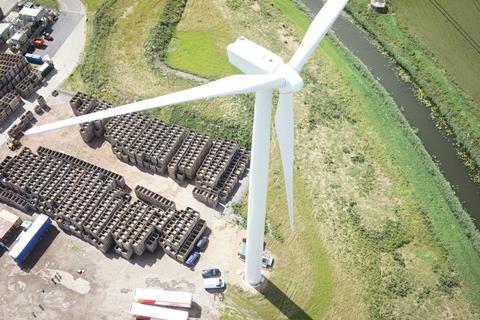
A major transformation in battery storage technology is set to “complete the picture” in renewable energy by allowing energy from solar and wind generation to be stored and used during times of peak electricity prices.
Batteries based on the lithium chemistry seen in modern electric cars are now being used on farms, with prices coming down by up to 20 per cent a year. This reduction in costs is similar to the development in solar technology over the past few years, which led to a breakthrough in this sector, explains the NFU’s chief renewable energy adviser, Jonathan Scurlock, who expects battery usage in agriculture to become “widespread”.
“Battery technology completes the picture,' he says. 'As solar gets cheaper and cheaper, tariffs are reducing, and now it can be bundled together with storage. Any kind of chilled business would be very interested in technology that allows them to avoid buying electricity at peak time.
“It’s apparent now that wind and solar are becoming the cheapest forms of renewable energy, and in some cases they are complementary with solar in summer and wind in winter.”
Once the token green energy gesture, renewables are now a major player in the UK energy sector with a raft of records achieved this year alone. In April, the UK had its first non-coal electricity day since the 1880s, while the cost of offshore wind energy made headlines recently when it dropped to cheaper than the price of new 35-year nuclear energy contracts. Meanwhile, the recent Clean Growth Strategy formalised the government’s commitment to green energy, providing the certainty that will ensure further growth.
For fresh produce businesses, one of the most important benefits of renewable energy is the chance to take control of their energy. “Many UK businesses are looking to on-site renewables as a solution to manage energy costs in a volatile market and to improve environmental credentials for a competitive edge,” says Monika Paplaczyk, senior investment manager at Thrive Renewables. Thrive provides lease agreements for renewable energy generation as a way of reducing capital costs and worked with potato packer Greenvale to provide and install a wind turbine to complement the company’s solar PV installation.
While overall costs are coming down meaning tariffs are generally smaller, there are some variables, with changes to tariff structures meaning larger-scale biomass boilers now look interesting, says Tim Pratt, technical director of the Farm Energy Centre (FEC).
Fuel type is now a bigger concern for those investing in biomass, continues Pratt. “Historically, biomass boilers would be fuelled with virgin wood chips. But that comes at a price, the RHI tariff used to lower that. Now the tariffs are lower, growers are taking more care on optimisation and consistency and using cheaper fuels.”
Heat ground pumps are another option for those with protected horticulture operations and these systems are currently benefiting from slightly higher feed-in tariffs. Water is heated via a network of underground pipes, which work most efficiently when heating to around 55 degrees, meaning additional energy may be required to meet greenhouse needs, says Pratt. “It is quite doable in the right circumstances but needs a lot of preparation,” he adds.
For Scurlock, while planning permission for wind remains challenging it is not impossible. “If you’ve got wind resources it’s definitely worth looking at,” he says. “Almost everyone should be doing solar – it’s almost a no brainer. Any kind of roof space can house panels. Anaerobic Digestion is useful if you’ve got a packing business with lots of green matter to use up.”
While investment in Combined Heat and Power (CHP) boilers continues apace, the long-term prospects of gas pose some concerns. “We don’t have a lot of gas in storage in the UK. Britain’s reliance on imported gas will rise,” says Pratt, while Scurlock says there is “a big job to do on replacing natural gas”. “There is a very big market to fill there, it’s something we think large-scale anaerobic digestion could help with,” he adds.
Opinions are still divided as to how companies should combine various renewable systems. While Scurlock sees investing in multiple systems that are linked via battery storage as increasing viable, Pratt says that one larger system still yields better economies of scale and returns on investment.
Another key message is that matching energy output to energy requirements is an important part of a robust economical strategy in renewables. “Satisfactory returns are only likely on sites that use pretty much all of the electricity themselves, to capture the full value of avoided import electricity,” adds Pratt.



